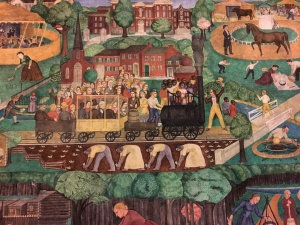Main Page: Difference between revisions
No edit summary |
No edit summary |
||
| Line 12: | Line 12: | ||
{{Display censorship incident | {{Display censorship incident | ||
|ongoing=no | |ongoing=no | ||
|year= | |year=1934 | ||
|region=North America | |region=North America | ||
|artist= | |artist=Ann Rice O’Hanlon, | ||
|subject= | |subject=Political/Economic/Social Opinion | ||
|confronting_bodies= | |confronting_bodies=University of Kentucky | ||
|medium= | |medium=Painting, Public Art | ||
|date_of_action= | |date_of_action=November 25, 2015 | ||
|location= | |location=Lexington, Kentucky, United States of America | ||
|description_of_content= | |description_of_content=Ann Rice O'Hanlon was a 20th-century American visual artist who painted murals. An alumna of the University of Kentucky, O'Hanlon painted a wall-length mural (fresco) inside the university's Memorial Hall in 1934 as part of the Treasury Relief Art Project with funds from the Works Progress Administration (WPA). The 11 x 38 foot fresco depicts the history of Kentucky through a series of vignettes, including explorers on the frontier, horse racing and scenes of downtown Lexington, the construction of log cabins, fishing off a bridge, passengers riding in a train, and horse training. It includes depictions of African-Americans picking tobacco in the fields, white people dancing to music played by black musicians, and a Native American peering from the woods at a white woman gathering water from a stream. | ||
|description_of_incident=Students of color at the University of Kentucky objected to the mural. In a November 23 statement issued two weeks after a meeting with two dozen African-American students, University President Eli Capilouto related this comment: | |||
"One African American student recently told me that each time he walks into class at Memorial Hall he looks at the black men and women toiling in tobacco fields and receives the terrible reminder that his ancestors were enslaved, subjugated by his fellow humans. Worse still, the mural provides a sanitized image of that history." | |||
| | |||
On November 25, 2015, the administration covered the entire fresco in white fabric. Capiluoto referred to the shrouding as an interim action, as a "long-term answer will take some time." Capilouto also created a task force made up of faculty, staff and students. | |||
|image= | |description_of_result=In response to the incident, the American poet, novelist, and activist Wendell Berry wrote an op-ed in the Lexington Herald-Leader denouncing the University of Kentucky’s decision: | ||
"The president...objects to the fresco on the grounds that it reminds 'one black student... that his ancestors were slaves.' That statement has at least two arresting implications: (1) that black students should not ever be reminded that their ancestors were slaves, and (2) that white students should not ever be reminded that their ancestors were slave owners. Do students, then, study history at our 'flagship university' in order to forget it?" | |||
In April 2017, the administration removed the drapery and the mural was once again visible; after nearly two years under wraps, the task force had concluded that the mural should be displayed, but with accompanying wall text to give historical context to the work. Signage describing its history, including the concerns voiced about it over the years, was added nearby. | |||
In an [https://www.kentucky.com/opinion/editorials/article100481602.html Op-Ed], UK President Capilouto stated: | |||
“Against that backdrop, the concern, for many, is that the mural does not adequately reflect the violence and inhumanity that many experienced through subjugation and slavery,” he said. “Those questions of intent, context and perception have become part of a larger conversation at UK about racial climate. And, as is so often the case, we’ve been led by students.” | |||
In August 2018, [https://www.chronicle.com/article/What-the-U-of-Kentucky-Did/244269? The Chronicle of Higher Education reported] that the University of Kentucky commissioned Philadelphia artist Karyn Olivier to create a work that responds to O’Hanlon’s mural. A committee was formed to solicit a public artwork in response to the mural and surrounding controversy. After issuing an open call to artists for submissions, the committee invited Olivier and another artist to submit final proposals. They selected Olivier’s project. Her work is now installed in the dome of the building's vestibule, to be seen before entering the room that houses O’Hanlon’s mural. The installation covers the domed ceiling in gold leaf, with black and Native American figures from the mural interspersed in the gold field, along with four portraits of influential black and Native American Kentuckians. A quotation from Frederick Douglass is displayed around the dome's lower edge. | |||
|image=UKentucky.jpg | |||
}} | }} | ||
[ | {{DISPLAYTITLE:<span style="font-style: italic;">University of Kentucky Memorial Hall mural</span>}} | ||
[https://www.chronicle.com/article/What-the-U-of-Kentucky-Did/244269? What the U. of Kentucky Did About a Controversial Campus Fresco Depicting Slavery], By Claire Hansen AUGUST 14, 2018 | |||
[http://ncac.org/blog/shrouding-history-or-protecting-students-university-of-kentucky-covers-1930s-mural Victory: A Year On, University of Kentucky Uncovers Controversial Mural Depicting Slaves, NCAC, BY SVETLANA MINTCHEVA, orig. post Dec 3, 2015; Update: Apr 21, 2017] | |||
[http:// | [http://www.kentucky.com/news/local/education/article140580518.html Controversial UK mural uncovered, this time with context, BY LINDA BLACKFORD, March 24, 2017] | ||
[ | [https://ncac.org/censorship-news-articles/confronting-the-past-in-paint Confronting the Past in Pain[t], OCTOBER 7, 2016 BY NCAC STAFF | ||
[http:// | [http://www.theamericanconservative.com/dreher/wendell-berry-vs-political-correctness Wendell Berry vs. Political Correctness, By ROD DREHER, December 1, 2015] | ||
[http:// | [http://www.kentucky.com/opinion/op-ed/article47230635.html Op-Ed: Censors on the flagship, BY WENDELL BERRY, November 30, 2015] | ||
[http://www.kentucky.com/opinion/editorials/article100481602.html Moral of UK mural debate: mutual respect: Kudos for uncovering a work of art and unveiling a new commitment to a diverse, inclusive campus], Lexington Herald Leader, Sept 7, 2016 | |||
[http://ukcc.uky.edu/cgi-bin/dynamo?maps.391+campus+0049 Campus Guide –Memorial Hall (Full image of mural)]. | |||
<!-- END FEATURED CASE --> | <!-- END FEATURED CASE --> | ||
Revision as of 19:09, 1 May 2019
|
